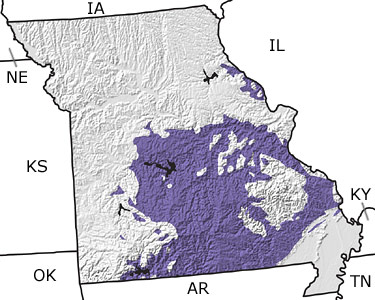Paleontology and geologyOrdovician rocks are well preserved in Missouri and are exposed over much of the southeastern portion of the state. The oldest of these rocks are sandstones. Interbedded layers of sandstones and shales indicate a fluctuating sea level. A large unconformity marks a global sea-level drop during the middle of the Ordovician. The sea returned to the eastern part of the state later in the Ordovician. A layer of bentonite (clay formed from volcanic ash) found in Missouri's Ordovician rocks is probably the result of a significant mountain-building event (the Taconic Orogeny) occurring far off to the east. Approximately 3,200 of Missouriís more than 5,300 caves occur in Ordovician-age rocks. Brachiopods, bryozoans, gastropods, trilobites, and corals are common Ordovician fossils. Fossils of monoplacophorans (cap-shaped molluscs), cephalopods, echinoderms, and conodonts also occur in some of these rocks. |

